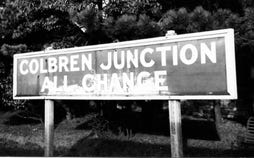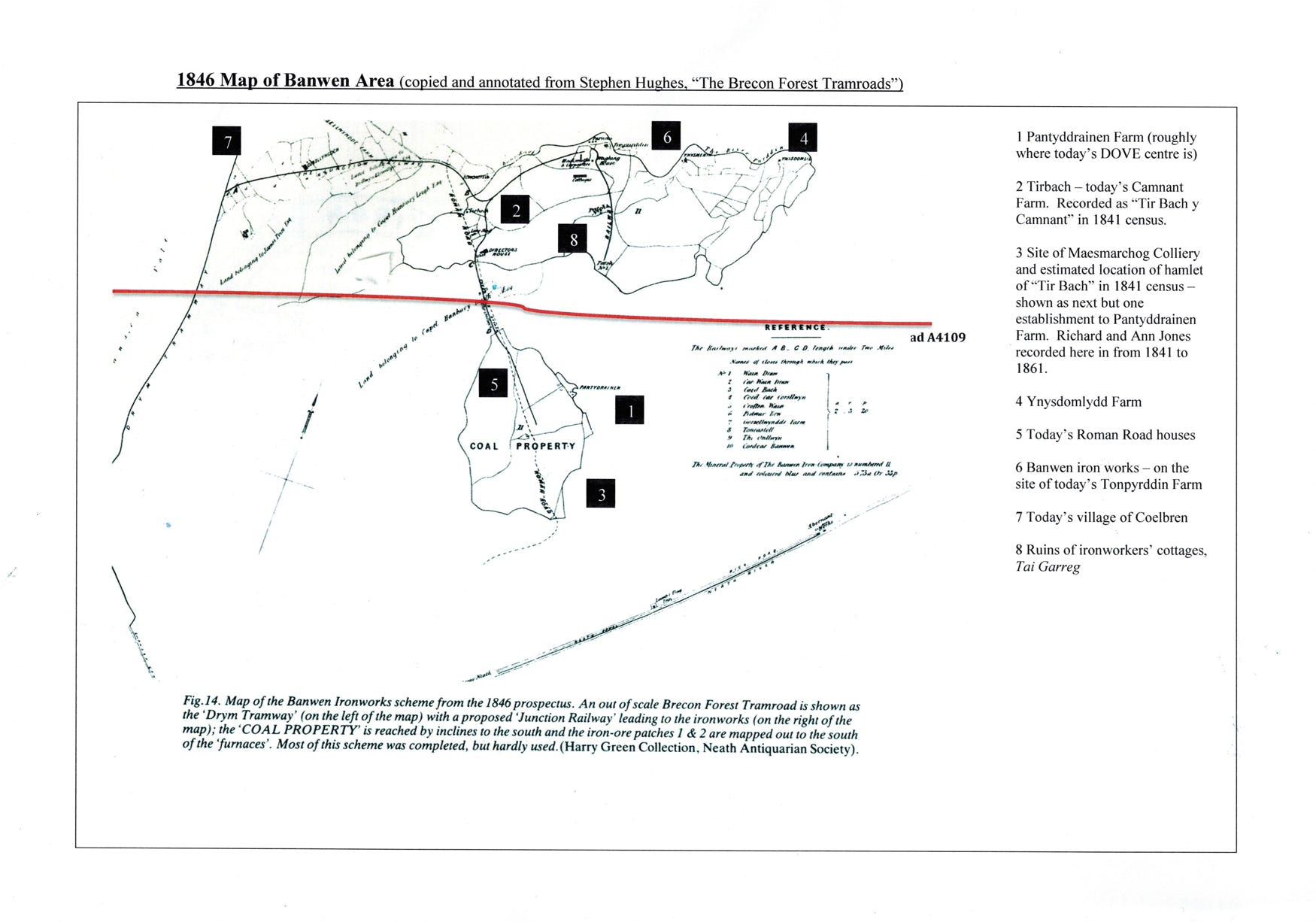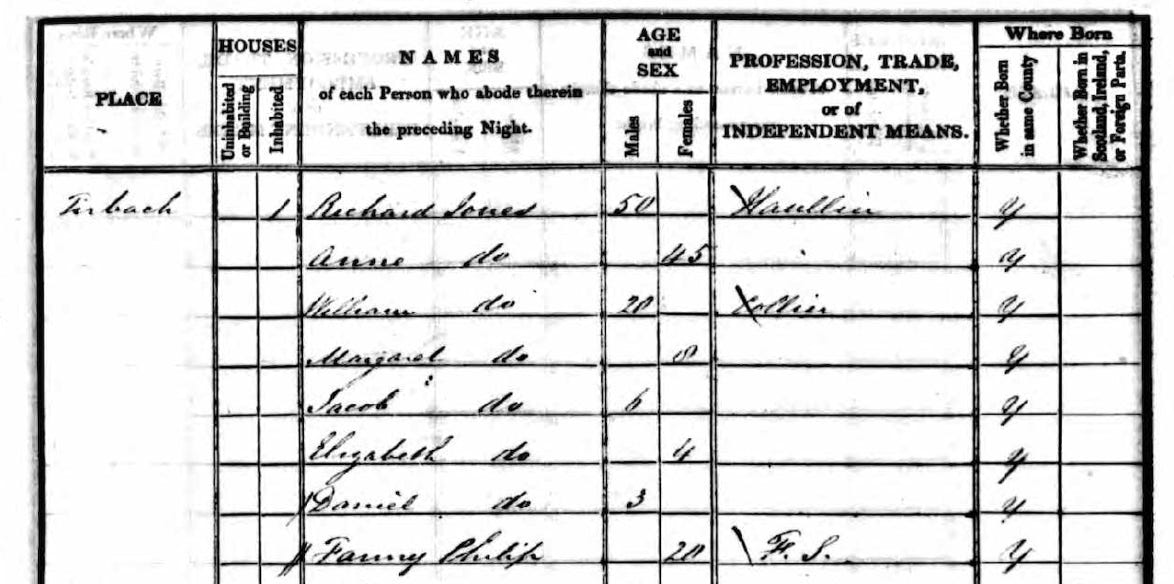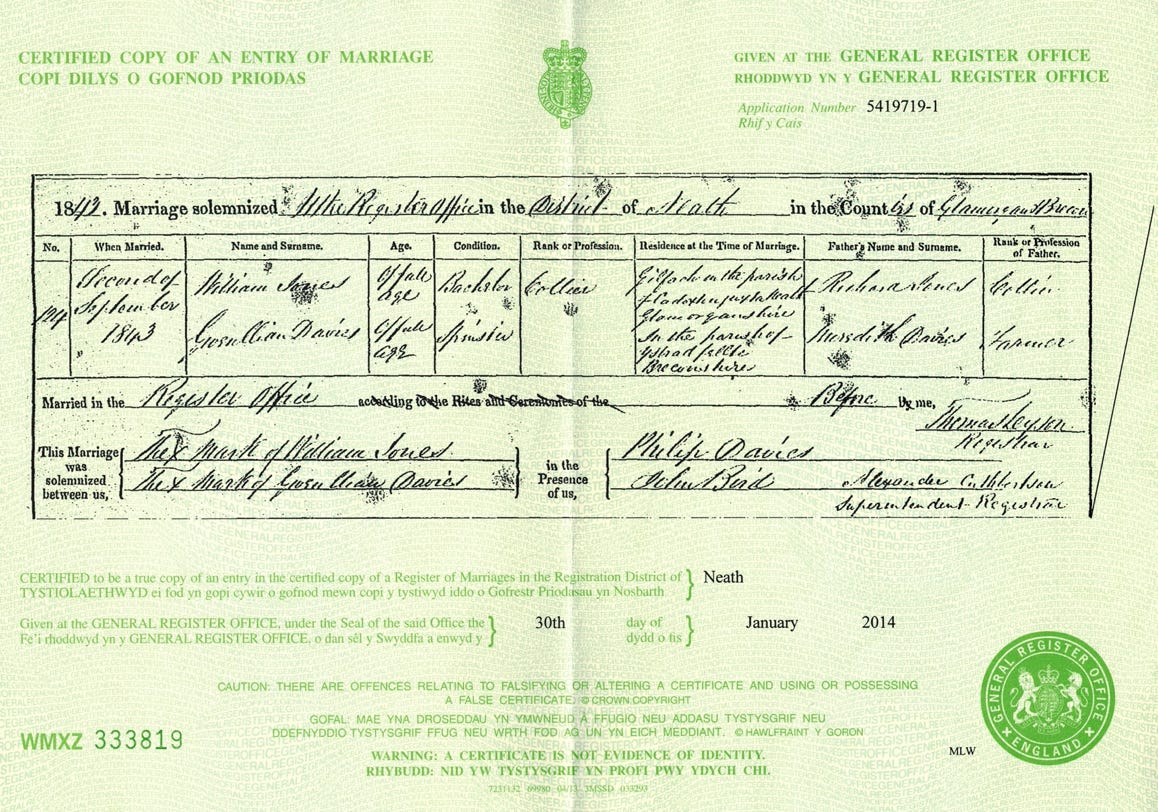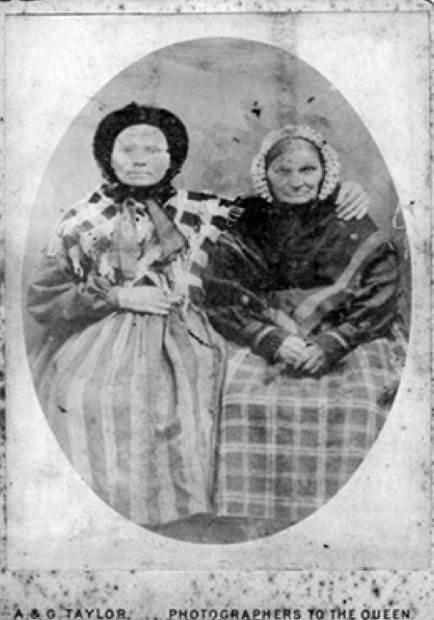From our first Jones family of Richard Jones and Ann James, we now focus on one of their children: William Jones (1820-1879), believed to be the eldest. He and his wife, and their own children, were to be quite prolific and we will now begin to see how the family created by William Jones and Gwenllian Davies forms the basis of our and scores of other Jones families at Coelbren.
The first record so far identified for William Jones is his presence aged 20 with his parents on the 1841 census up near the emerging colliery at Tir Bach; he came of age at exactly the same time as the homeland of his childhood would undergo massive transformation. William is shown with father Richard and mother Anne. Father’s occupation is shown as “Haulier” – which was the term in the colliery for one who literally hauled the coal away from the face, usually by now with the help of a horse, although in the smaller mines with narrower headings, children often first had to haul coal to the main roadways. William, aged 20, is a “Collier”, meaning he could have been anything from a hewer to a general labourer. These were early miners in the area, although not the first. Coal had been mined commercially for purely local markets in a generally haphazard way since earliest times, and coal had always been taken for solely domestic purposes from wherever it could be found in the shallow outcrops. Some suggest even the first century Roman visitors would have used whatever coal they could find easily. At this time, the term “colliery” was a rather loose description for a series of localised drifts, but nevertheless at this time the closest organised collieries can be identified as Maesmarchog, Onllwyn (Drym, Drim or Drum) and Aberpergym, in any of which the Jones men could have worked.
In 1842 the Royal Commission interviewed Mr. Richard Penrose, the then owner of Maesmarchog Colliery. He said he employed 32 people, 15 of whom were under 18. One was under 13 – but, according to Mr. Penrose, only employed as a door-boy (opening and shutting doors in the mine to let through horses and their loads – called journeys – also helped ventilation). He seemed to be at pains to point out that “horses do our work and a girdle and chain is not required.” – meaning humans didn’t have to haul the coal. However, in January 1858, Mr. Penrose was brought before the Neath Magistrates, charged with employing a boy under 10 years (a John Pine, who was 9 years 5 months). Predictably, the proprietor Mr. Penrose strenuously denied all knowledge of the boy’s employment, blaming his overseer, Hopkin Hopkin, for employing the boy. Penrose was acquitted and the overseer charged. In mitigation, Hopkin claimed he employed the boy to support his father who “had a lot of children and was sick.” He was “fined £5 and costs but the penalty was remitted at the request of the prosecutor” (as reported in the Merthyr Telegraph). Perhaps the prosecutor recognised the dual injustice of the situation.
Before mining took its complete hold, this was a very sparsely populated rural area. Here, as in many other pre-industrial areas, it was not however coal on its own that formed the first industry; apart from for purely local use, there was no real original reason to mine coal for its own sake on a large scale, with very poor if non-existent transport links to take it away. In this area, one of the first uses for coal was to burn limestone taken from the nearby Penwyllt quarries. Later, from the early 1840s, came iron; there were also rich local deposits of iron-ore and once new technological processes allowed the local anthracite coal to be used in local furnaces, true industrial integration started, but was to be short-lived in this form. In earlier (i.e. 1841-1861) census returns we see a regular mix of self-declared returns as “farmer and miner”, such dual-occupation being characteristic of early mining areas. Before mining in the later nineteenth century became totally monolithic and practically the sole option for employment – the local small-scale iron furnaces now proving uneconomic and concentrated elsewhere - the earlier inhabitants would typically combine “farming” with work in the various mines as they established themselves. Such farms or smallholdings, though, would generally be poor affairs, on a very small, almost subsistence scale, a constant battle with scrubby pasture and the weather of the high country. Despite the difficulties, this would still be practice continued into the twentieth century: Francis & Smith (1998) note that “The Anthracite miners also suffered less in the [1926] seven-month lock out because, being a semi-rural coalfield, many could live off the countryside whilst others were still part-time farmers." Some farming skills were useful in the mine: the proper cutting of timber for roof supports, for example, was a skilled job and,
“the countrymen, early on, used to come in taking jobs as repairers…the old countryman would be coming in, taking a lot of pride in notching his timber, and having the right size, and all the architecture of a good repairer
from a recording of Howell “Jeff Camnant” Jeffreys, in Evans (1976)
Of Banwen colliery:
“Resin oozed from the notches cut into the crossbeams, forced out by the constant downward pressure from the roof, and brought with it the fragrance of the forest.”
Evans (2000)
I find it interesting that Howell Jeffreys came from a smallholding, itself somewhat outside the very small village of Coelbren but still considered himself different to the “countryman”. This reflects the very early incorporation and affiliation of these little villages with the urban and industrial, still Welsh speaking, but moving quickly into the capitalist and English nexus as the supporting railway and media infrastructure developed around them.
In one sense these earlier farmer-miners were luckier than their many children – who, due to their numbers, could not all be supported into adulthood and would mainly have to move out – and as farmers of sorts, they also had some degree of protection against the vagaries of waged employment. In the early life of the collieries (early 19th century):
“...the people of Onllwyn did not concern themselves unduly about strikes. Such a form of organised action never entered their minds. To them employment at the colliery or tramroad was only something to supplement living on the farm. When they had work to do on the farm , they just didn’t turn up for work at the colliery. When Mr Christy had orders for coal he would go around the farms to ask the people to come to work. You can imagine the answer he had at harvest time. They soon realised that this put them in a rather favourable bargaining position. Of course this acted on occasions in reverse.”
C. Evans, (1977)
Not all mines, especially the smaller ones, worked continuously and there were frequent stoppages as old seams were exhausted and time taken for new ones to be opened, Throughout, men were, of course, paid strictly on a piece basis - according to the constantly negotiated “price-lists” - and therefore paid only for coal actually extracted. The mines themselves changed ownership regularly according to the perceived value of their stock. Some stability only seems to have come as late as 1909 when the Evans Bevan company took control of most of the collieries in the Dulais Higher area, ceding ownership only on nationalisation in 1947 to the mixed blessings of the National Coal Board (NCB).
The rapidly growing indigenous population as well as many incomers to the area would on the other hand be later put up in barrack-like rows of inadequate, jerry-built “cottages” – the name then did not have today’s cosy connotations - like the “Front Row” and “Back Row” at Onllwyn - the entirely utilitarian naming and paucity of imagination speaking volumes of the owner-builder’s aspirations for his workforce. In this case, it was John Williams, ironmaster. Although much of the local anthracite later ended up being exported, in the early days it fuelled the various small and speculative iron works in Banwen and Onllwyn and was also transported by horse-drawn tramway systems to the larger works at Yynscedwen and Ystalyfera, before the concentration of all iron production in these and other large establishments.
Just across the Banwen “bog”, formed by the sources of three rivers - the Dulais, Llech and Pyrddin - at Dysgwlfa (“the lookout”), was Meredith Davies (approx. 1785-1858), “Farmer”, his wife (Jennet Pritchard) and family, including daughter Gwenllian (born 1823) aged about 15 (after 15, ages were rounded to the nearest 5 years in the 1841 census). Two years later, Gwenllian is recorded as being “of full age” when she married William Jones in September 1843. William’s residence is now given as “Gilfach” – quite possibly the nearby farm of Ton-y-Gilfach to where at the age of 22 he may well have moved to work. In any case, and entirely predictably in such a rural area, bride and groom lived almost adjacently.
Marriage of William Jones and Gwenllian Davies, Neath Register Office, 2 September 1843. Both give their mark as ‘X’. Illiteracy is pervasive among the working population at this time. Source: GRO (General Register Office)
George Brinley Evans remembers the “Bog” thus:
At the centre of the Bog there was a wishing gate that marked the boundary between Glamorgan and Breconshire, the reeds were higher than your head, frogs, toads and in the spring, tadpoles by the million. In the summer, dragonflies and damsel flies, glistening like jewels, floated in the warm air. Marsh marigolds, water forget-me-nots, southern marsh orchid, lichen covered willows, the tall, ripe, golden stems of the reeds with their feathered crests…And legend has it that there is a town sank out of sight, in the time before the Romans, a crannog under the Bog….the local people called the land “Ton-yr-ynwyl y drew” - the flatland at the edge of the town. Bog would have been the last name he would have chosen for this enchanted place.
Evans, 2006
By the 1851 census, the new family had settled at Ynysdomlydd, a smallholding just southeast of Coelbren next to Dysgwlfa. Even by local standards, these little farmsteads are remote: still now, most are well away from the main road through the area, the Intervalley Road, which itself only dates from about 1928. The farm cottages are notched in to the little dips and clefts that follow the meanders of the Nant Hir. Indeed, in 1851 William Jones proudly proclaims himself as “Miner and Farmer”. The family had been here since at least 1848 as the Banwen Iron Company’s License of that year mentions “Ynistomlyn [sic] Farm late in the occupation of Meredith Davies, now of William Jones.” William and Gwenllian wasted no time in applying Biblical law and indeed between 1844 and 1867, Gwenllian dutifully bore her husband at least ten children who survived infancy – with a gap of no more than three years between any of them. Little wonder she died, probably exhausted, at the age of 49, in 1872. All four sons become colliers.
Four out of six daughters for whom marriages can be found married colliers.
Above: extract from the account book of tailor Richard Morgan, of Colbren, recording that he made a suit for William Jones’ son, Daniel, aged about 14, price £1 10 shillings. Ten years later, Daniel would marry one of Richard Morgan’s daughters, Anne.
The names Jones and Morgan, just to take two examples, are amongst the worst offenders in Welsh family history. However, our families in earlier times did generally make it easier (for the contemporary researcher) by sticking together and generally staying put in the relatively sparsely populated hinterlands of these valleys – no great move is apparent to the gold-rush (or iron, tin or copper…) towns of Merthyr Tydfil or Swansea. Boys tended to oblige us by marrying girls from close or even adjacent farmsteads and later colliery rows.
Our ancestors have also helped us to find them by largely following custom in naming children: they married young and named the first son for the paternal grandfather, the first daughter after the maternal grandmother, and so on. The families also obliged in neatly repeating the same structures generation after generation – they conformed unwittingly to the capitalist imperative – lists and lists pop up on censuses of “Occupation – Coal-Miner”, “Son Collier” (long lists), “Daughter ----- “ (insignificantly nothing, waiting for marriage).
Despite the name problem, linking these families through the generations is paradoxically straightforward precisely because of their uniformity, immobility and essential predictability. In this period of the nineteenth century, there was also little need for anyone to move away from the area as the local collieries provided ample employment. This contrasts, for example, with families in more rural mid-Wales where a lot of dispersal is seen at this time.
Of course, and inevitably in a small area, we also have very close bonds between the same families, intersecting across generations: here, marriages between Bryant, Evans, Jones, Jeffreys, Kemeys, Lewis and Morgan families figure prominently and repeatedly. Many of them were probably the same type of family – chapel with trefn (trefn: neatness, tidiness, order) and it is no surprise, for example, that practically all the men quoted by WT Davies (1994) in “Coelbren School” as the “prime movers” behind the later establishment of the said school were related in some way. Of seven mentioned, five - Lewis Lewis, David Kemeys, Rhys Jeffreys, Daniel Jones and John Morgan – were either cousins or in-laws to varying degrees. Several children of these families would also later become teachers at the village school at various times, and others went on to teach further afield.
Rows of colliery terraces in Onllwyn also held the same families, brother living next-door to sister and other in-laws. This became particularly the case for this family in the late nineteenth century once the original and mainly Irish inhabitants of Front and Back Row, Onllwyn had either moved on or been assimilated. Extended family kinship was usually strong and with no welfare state, one’s family was all one had, later the “Fed” (the South Wales Miners’ Federation, later part of the National Union of Mineworkers) possibly a little way behind. Such “self-help” was not philosophically inclined, it was the only alternative to poverty. When family units did not follow the neat and predictable pattern described above, things got harder and less predictable. It is now also at this point – in the last quarter of the nineteenth century - that we see the once peaceful high plateau here turn its inhabitants' outlook from the fundamentally rural to the industrial.
William Jones became a probable victim of industrial disease in 1879 – although it was never stated as such on death certificates, in those days - aged only 59, when his death certificate records a cause of death as “Pleurisy 6 days, Pneumonia 5 days”, on the 29th January 1879. Son Meredith had been married in Neath only 11 days before. When William died, Joan (aged 20), Daniel (17) and John (12) remained unmarried, effectively orphans, and had to fend for themselves.
William Jones’ grave has not yet been found and further research awaits. This family generally followed the Independent cause but William does not appear in burial records for chapels such as Tyncoed (Abercrave) or Addoldy (Glynneath).
Funeral parties were known to cross the mountain from Banwen & Onllwyn to Glynneath and at one time it is said that a small alehouse was located somewhere up the mountain – for the refreshment of the bearers and other travellers. This may have been the establishment known as the “Traveller’s Rest”, perhaps the same one known later known as the Whistle, or the Pig and Whistle, because of the greyhound races that took place nearby. This establishment was said to have been next to the Maesmarchog colliery.
